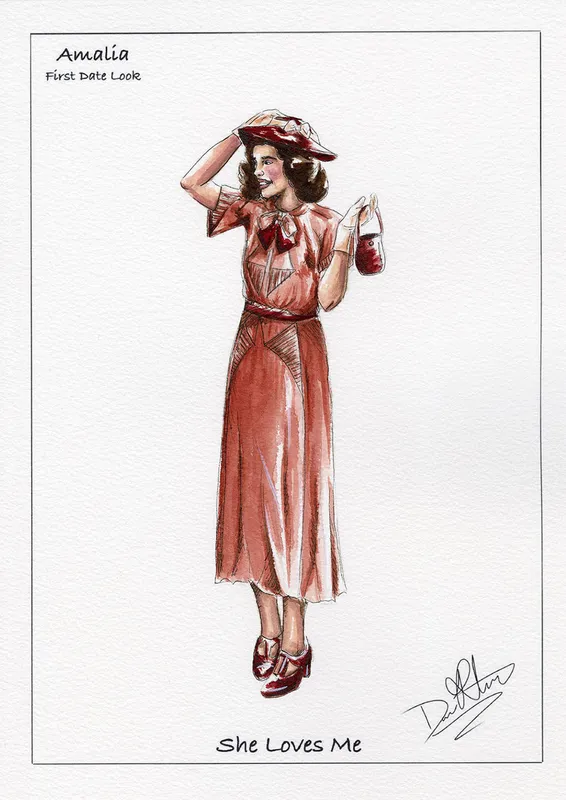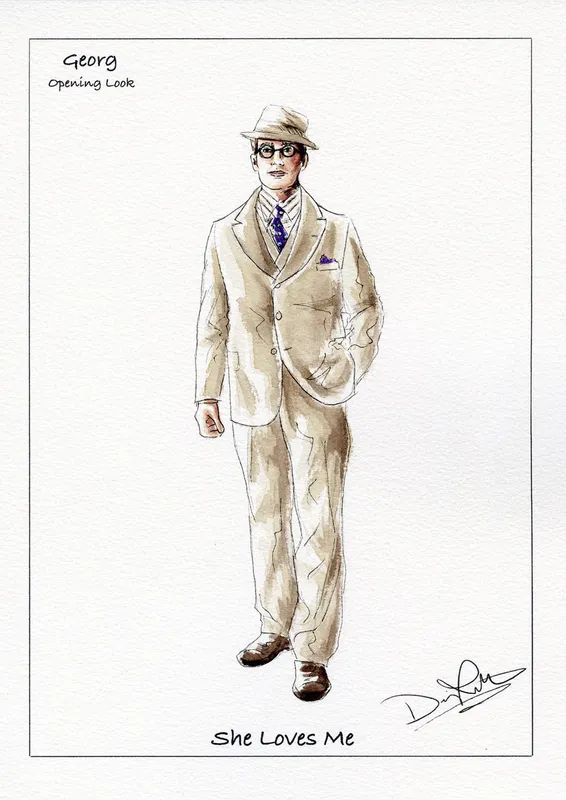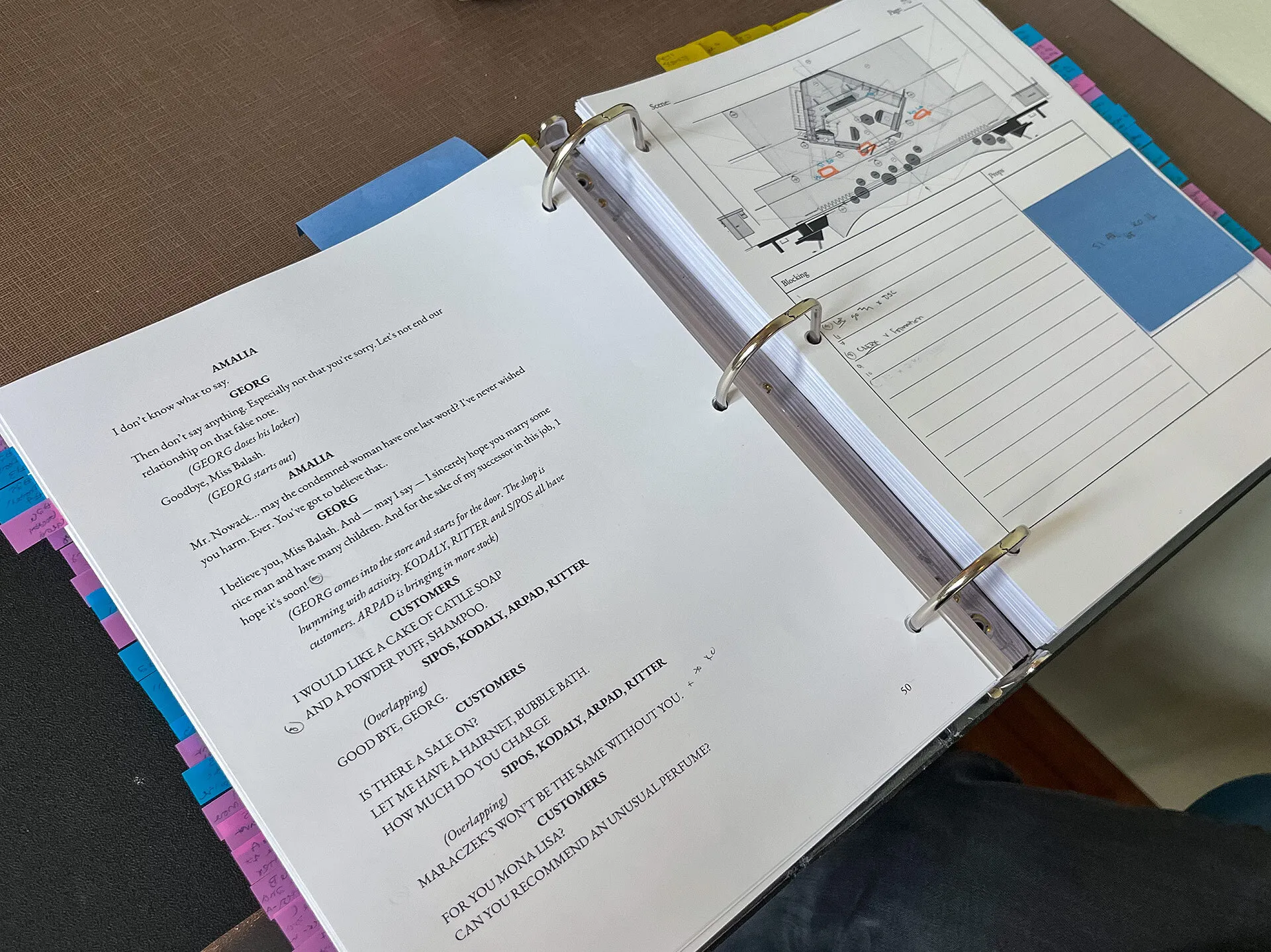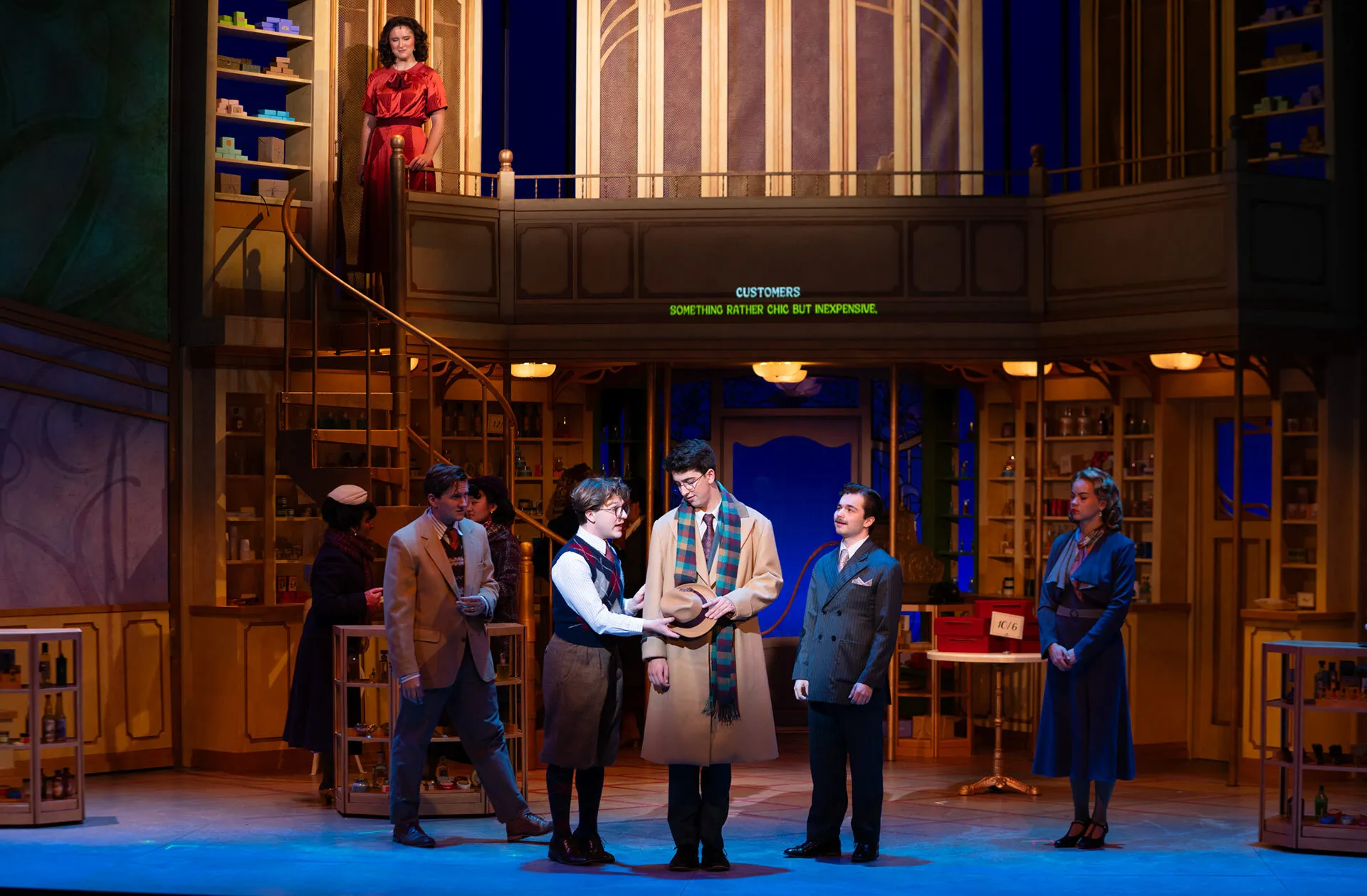- October 21, 2025
- By Karen Shih ’09
Looking for a little break from the post-break barrage of midterms, essays and lab assignments? Take a colorful trip back nearly 100 years—without leaving campus.
“She Loves Me,” a breezy 1930s rom-com that inspired the Tom Hanks-Meg Ryan flick “You’ve Got Mail” and numerous other adaptations, is playing at The Clarice Smith Performing Arts Center until Saturday. It’s set in a perfume shop, where two bickering coworkers become anonymous pen pals through a newspaper’s lonely hearts club, and of course, fall in love.
From the actors belting songs to the elaborate two-story sets to the perfectly tailored period costumes, the show is a labor of love by the students, faculty and staff of the School of Theatre, Dance, and Performance Studies (TDPS) and staff of The Clarice’s production team. It’s one of four major theater productions each year.
Stage manager Heather Hernandez ’27, a theater major, lead actress Emily Davis ’27, a theater and communication double major, and costume designer Doni Rotunno M.F.A. ’26 take us through the yearlong process of preparing a musical, from exhaustively annotating the script to sourcing fabric in New York to hydrating voices with a steam nebulizer.
A year ago:
Rotunno: Last fall, I submitted “She Loves Me” for consideration to the Performance Production Committee—I’m very drawn to that old Hollywood era—and the faculty, staff, and undergraduate and graduate student representatives, voted to add it to the season. It’s nice that students can have a voice, since the whole TDPS community can submit proposals.
Hernandez: Once it was announced, Assistant Director of Production and Operations Jenn Schwartz talked to me about working on the Spring 2025 shows, “For Colored Girls …” and the dance show “UMoves ‘25” to build up my skills and get ready to become stage manager in the fall.
A semester ago:
Rotunno: In February, we heard Director Nick Martin’s vision. I started working on sketches and fabric swatch cards. I saw this show in 2015 or so on Broadway—I didn’t know then it would become my thesis one day! But I made sure not to look up other versions as I designed.
Davis: I’m playing Amalia. She and Georg are the ones writing letters to each other. All TDPS students auditioned in February, so I prepared 90-second monologue and a 15-bar cut of a song (I sang “Somebody, Somewhere”). Then we go through callbacks, learning some scenes and even a dance, and then by Spring Break, the cast list comes out. I was an understudy last year for “Emma,” so it’s exciting to be an overstudy this time.
Rotunno: There are 15 characters, and the show spans summer through winter, so we change costumes for each season or for moments in the script where it’s written, like when Amalia goes on her mystery date and makes a comment about her new hat, shoes, dress, everything.
By the end of the spring semester, we’ve submitted our designs to the costume shop, we see where we land with budget, labor and who’s building what. Then we take a two-day fabric shopping trip up to New York to get everything we need to build from scratch.

Sketch of Amalia wearing a red dress. (By Doni Rotunno)

Sketch of Georg wearing a tan suit. (By Doni Rotunno)
Over the summer:
Davis: I worked a lot with my voice teacher at home, because there’s a lot of music and it has a very classical sound quality and tone. And I was trying to have my lines somewhat memorized.
Hernandez: As stage manager, I run the show, along with two assistants. I do lots of paperwork: the daily call, the rehearsal reports, the calendar. I reformat the script for stage management and type out the version for our open captions.
Rotunno: In mid-August, we meet with the costume shop staff. I make a packet of every look for every performer, from undergarments to accessories. They’ll give me feedback, ask questions, and then they start working. I really shop like crazy for those last two weeks before the semester, searching contemporary stores like Macy’s and H&M to vintage shops and Etsy.
Men’s sweater vests have been the bane of my existence. Nowadays they’re made to be very long, relaxed. But in the 1930s, they’re much tighter-fitting and shorter, almost like a crop top. They’re so hard to find.
The semester of:
Hernandez: We’re rehearsing five days a week, usually 5-10 p.m. on weekdays and 11 a.m. to 5 p.m. on Saturday, on top of our usual class schedule.
Davis: The first day back, we do a read-through with the director. It can be a little overwhelming because it’s not just the cast, but also lighting, sound, scenery and costumes, as well as our faculty advisor Associate Professor Lisa Murphy-Nathans, choreographer Amber Daniels and music director Marci Shegogue—almost 30 people total.
Rotunno: That’s my first interaction with the cast. We present their costumes, then we start bringing them into fittings.
Davis: There’s a lot of conversation that first day. Our director Nick will ask, “How is your character feeling in this moment?” I discovered so much about the tension between Amalia and Georg, why they push each other’s buttons—things you can’t get when you’re going over lines by yourself.
Building the chemistry of the characters is really important. We also work with an intimacy coordinator, Sierra Young. For anything like a kiss or handholding, it’s important to do boundary checks and make sure people are feeling safe and comfortable every day.
Hernandez: I’ve got a huge binder with the script where I annotate every line. There’s sticky notes for every act and scene, as well as where the songs fit in. As the cast rehearses, I’m taking notes for blocking, costume quick changes, where props need to go. We tape out the entire set on the floor of the studio.

Stage manager Heather Hernandez ’27 shows her annotated script.
Three weeks before:
Hernandez: In October, we move on stage. Tech week is when we have all the designers, the band, production around to start to pull everything together. Our longest day is on a Saturday, when we’re in there for about 10 hours to see scenery, lighting, costumes and more.
Davis: That’s the first day we’re in full wig, dresses, makeup, everything. It suddenly feels real: I can go up the steps, I can open this door. It all makes sense.
Rotunno: One of the most fun things is to play in the room with the cast. Maybe I add a slit in a dress so they can do a tango leg kick. They know their characters better than anyone, so we’ll pick out ties, and they might say, “I don’t think he’s there yet.” We also figure out what final shortcuts they need, like quick-rigging buttons or pre-attaching suspenders to pants.
Hernandez: By this point, the actors have everything memorized, but I’m still learning. My workload gets heavier because I’m finalizing all the cues for lighting, sound, set changes, when the cast needs to go on, so I can call the entire show.
The day of:

The employees of Maraczek's Parfumerie console Georg, played by Hayden Polsky '27 (center), before his first date with his anonymous pen pal. (Photo by David Andrews)
Hernandez: Opening day, I’m probably shaking like a chihuahua.
Davis: I’m in a corner somewhere, trying to breathe and meditate.
Hernandez: This year is kind of funky due to fall break. We’re doing our final dress rehearsal on the same day, a few hours before opening.
Davis: I use my steam nebulizer in the morning, carry cough drops and warm up my voice. I’ll avoid dairy, but I’ll have a little bit of coffee because I need it. I come in two hours before, and then we’ll do a physical warm-up; the assistant choreographer William Nash will lead us in jumping jacks, stretching. Then we’ll do vocal warm-up and scales.
Hernandez: We do a few last-minute calls to practice things like a trust fall off a chair in the middle of a song or more complicated choreography. My assistants will be with the cast backstage, while I’ll be in the house of the theater, communicating via a “god mic.”
Davis: Opening night is exciting. I just love how everyone is having so much fun. I didn’t enter college as a theater major, even though I performed a lot as a kid, but when I saw “The Prom” as a freshman, I was like, “I have to get back into this.” I’m so glad I did it. We have such incredible facilities and an incredible program.
This is part of a series that looks behind the scenes at “what it takes” to keep the University of Maryland humming and create a vibrant campus experience. Got an idea for a future installment? Email kshih@umd.edu.
